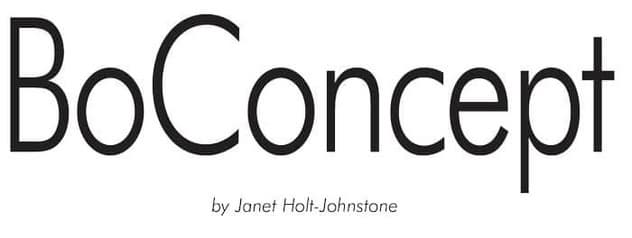
The new, Manhattan flagship store will set the stage for USA expansion of the 300 store global furniture franchise.”
If you happen to find yourself in the vicinity of the trendy, fast-paced shopping district of Madison Avenue, New York City, you’ll discover the gleaming, new flagship corporate store of BoConcept. The Danish-founded global retail furniture franchise, with nearly 300 locations across 60 countries, is in the midst of a aggressive push to gain new market share across the United States. The corporation is already established in Boston, Los Angeles, Miami, Seattle and San Francisco.
Madison Avenue will dramatically showcase BoConcept’s specialized home and office high-impact designs. Conceptualized by world-renowned industry royals like Oki Sato and Karim Rashid, styling is upscale, urban-minded and decidedly unique.
Corporate leaders are CEO Torben Paulin, CFO Morten Rose-Nielsen and COO Troels Dyrup Petersen. The previous CFO, Hans Barslund, retired this spring. His son is now about to take over the Miami franchise, Steen Knigge, Director of U.S. Marketing, told us. “It’s all family!”
Steen invites you to visit and see “The core of our brand, statement pieces that elevate modern design potential. Presenting our progressive designs in the heart of one of the world’s fashion centers puts us on a larger stage than ever before!”
He emphasized, “The very first ‘unique’ thing about the Madison store is that it will start as a corporate store. We are not changing our strategy of being franchisee-based. However, as we are ending our 14-year long relationship with our current New York City franchisee (Niki and Shaokao Cheng) on August 31 this year, we want to make sure we have uninterrupted presence in Manhattan. Another unique part of the store is that we will work on our new merchandising concept for potential roll-out across the chain. It will give us first-hand knowledge of validity, a level of control we do not normally have in the U.S. market.
“And, finally, it serves as our ground zero for the upcoming expansion, a store where we will present BoConcept to new franchisees.”
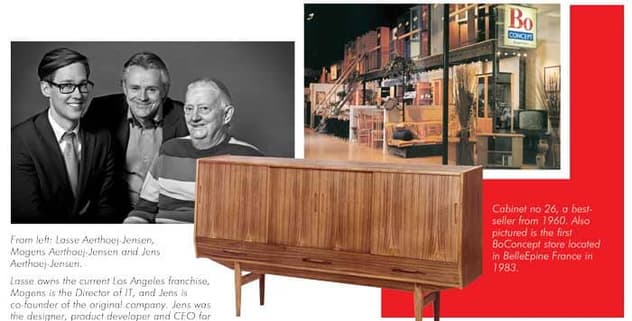
The name, BoConcept? “It’s derived from the Danish word ‘bo’ which means ‘living’ or ‘to live’... the ‘Living Concept’, the concept of living. Basically, it describes the holistic approach BoConcept takes to creating furniture for every room in the house, while still remaining true to the Danish heritage.”
But let’s go back six decades to the more contemplative, slower-paced environment of a carpentry school in the town of Aarhus, Denmark. Two young students, Jens Aerthoj and Tage Molholm, both cabinet makers with some experience under their belts, were seeking additional training in drawing, construction, calculation, book keeping and economics. They became friends. After graduation, Tage worked in a furniture factory and Jens took part in Denmark’s national service program. But while Jens was serving in the military, his rapidly developing family and many friends urgently needed to furnish their homes. So he made a bold decision. When once again a private citizen, he bought his former masters’ workshop in Herning, a picturesque town four hours by train from Copenhagen.
When we think of Denmark, what does our mind conjure up? Hans Christian Andersen, Copenhagen’s little mermaid, the scintillating Northern Lights, Elsinore and Hamlet. And, of course, the genius of the multi-faceted sculptor and designer George Jensen. Beauty and creativity abound in Denmark. With such environmental and artistic inspiration and his own good common sense, Jens, now a master cabinet maker, had flexed his innovative muscles back at carpentry school and designed a well-conceived desk, and a dining table with six chairs. Unfortunately, none sold particularly well. And, on top of that, Jens was lonely, it was dreary working by himself. He thought of his school friend, Tage, and invited him to visit Herning one hot summer day. It was 1952, the beginning of it all.
Tage was immediately interested and a partnership was formed, the Aerthoj-Jensen & Molholm Furniture Factory. Steen Knigge continues the story: “Armed with their tools, saw, plane, try square and chisel, the two men could make any kind of furniture. But they decided they didn’t want to. Machines were becoming more common and precise. Their idea was to let the machines do all the hard work, leaving the cabinet makers to focus on the important details.
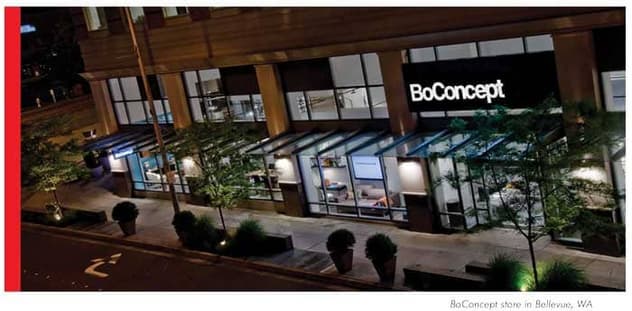
“Jens was dedicated to and skilled in furniture design, and Tage was experienced in industrial furniture production. They both agreed that mass production and industrialization was the way forward. This would allow them to keep prices down without compromising quality, and make well designed furniture affordable to a much wider audience. Many furniture factories had failed to make this transition successfully. But for the Aerthoj-Jensen & Molholm Furniture Factory, the new ideas and vision made complete sense.
“Tage Molholm managed the assembly and painting departments. The factory employed a staff of 15. By the late 1950s, there was no room for further extensions on their industrial site. But production demanded increasing space. They were using more and more machines, a milling cutter, circular saw, band saw and the first veneering press in the Herning area. And, vitally important, there was also a growing pool of customers who wanted more furniture!”
The ‘50s, was the era of the exciting Scandinavian furniture design revolution and the concept rapidly surged globally. The clean lines, the attention to the maxim, “Form follows function”, captured imaginations. The fledgling company produced dining room furniture, then added cabinets and wall systems. By 1970 the employee roster had doubled and the product lines included beds, wall systems and bookcases. They became a limited company, A/S AEJM MOBLER. In 1979, the first flexible furniture system in Denmark appeared and the concept of interaction with customers began to evolve, “They could become their own bookshelf designers”.
The introduction to the Copenhagen Stock Exchange in 1984 also marked the birth of the Capri wall system, the first of the “knock-downs” and, in the factory, more CNC controlled machines were utilized to give designers “a freer hand”. Four years later chests of drawers and children’s furniture were introduced.
On the edge of the Millennium the by now four production facilities in Denmark merged and, that same year, upholstery (“modular, flexible, youthful!”) was added to the line. By 2002, a new strategy emerged. The company moved dramatically to a focus on retail.
To ensure “the best shopping experience” for customers, 2004 marked “the founding of BoConcept University, created to train and educate sales consultants from all over the world in service and interior design”.
But a glitch occurred in 2008... the worldwide financial crisis. “After years of growth, decreasing sales forced BoConcept to optimize and fine-tune the whole organization.” In the midst of reorganization, interior design services were introduced, reaching out to the consumer by booking home visits, providing them with design advice, offering 3D drawings and style tips.
Four years later, in spite of the international crisis, growth continued. The Shanghai Distribution Center was added “to help the expansion strategy in Asia”. And, on-line shopping was “now open for customers on websites in select countries”.
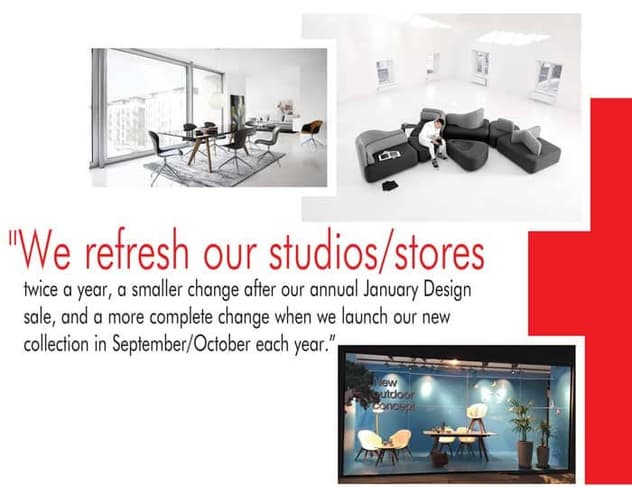
In its 60th Anniversary year, BoConcept had more than 260 stores worldwide. The corporate structure there was undergoing a transition. "The evolution from wholesale to retail outreach," Steen explained, began when “There was enough furniture to set up inspiring shop-in-shops in existing furniture stores. Then, in 1993, the first brand store was opened in Paris.” And the French loved Danish design. It was then that the name BoConcept appeared.
“Just over a year later, there were seven BoConcept Brand Stores in France, the U.S.A. and China.” Most stores were opened as franchises from the beginning, although the first two stores in France were directly owned. “The first goal was to establish 75 Brand Stores and, during this phase, several countries saw rapid growth, for example, Japan, with five stores in just two years.”
In response to this came a decision to restructure in 1999. Mogens Aerthoj spearheaded a joint IT platform and combined activities to market four existing brands, Club 8, BoConcept, Zenia House and Dencon.
“In the meantime,” Steen told us, “the development and growth of BoConcept Brand Stores continued. In 1999, the company established a Danish upholstered furniture factory to handle production of sofas and upholstered chairs.” Now, in BoConcept Brand Stores, “Customers could purchase sofas for lounge rooms ranging in size from tiny to huge. They could also choose whether to cover their sofas in leather or fabric in precisely the colors they dreamt of.”
Amalgamation and streamlining took place under the definitive slogan, “One Company – One Brand”, this in 2002. “CEO Viggo Molholm made the biggest strategic decision since the day his father and his father’s friend, Tage Molholm and Jens Aerthoj, founded the company.” In the future the company would be retail-driven, focusing on one brand. The goal was that BoConcept rise to become the number one interior design brand worldwide.

The company made a big investment to support the strategy. That investment was their European Distribution Centre at a cost of more than DKK 100 million. The Center virtually ran itself, ensuring the efficient delivery of products to the company’s then 110 brand stores.
To emphasize their focus on retail, when their last wholesale customers disappeared in 2006, names were changed. Said Steen, “The name of the Group’s operating company was changed to BoConcept A/S and the public listed company to BoConcept Holding A/S. From this point on BoConcept design could only be purchased in BoConcept Brand Stores and Studios. In that same year, BoConcept relocated its upholstered furniture production to the Baltics, to optimize efficiency.
“Increased growth in Asia was also supported by the establishment of upholstered furniture production in China. Both factories are still managed by Danes with years of experience at Bo Concept. The outsourcing strategy was clear, the focus was on the customer. Production was, therefore, located where the best price and quality could be achieved as close to customers as possible.
“In stores, accessories were added to furniture collections so customers could buy all the furnishings for their homes. Accessories at BoConcept are a collection of Danish designed artistic household items sourced from all over the world, often from small suppliers with specialized skills in crafts like knitting and beadwork. Strict quality requirements naturally serve as the foundation for these partnerships.”
Steen continued, “Today, collection year 2018, we work with 10 ‘must have’ studios that are carefully selected based on purchase intention, sales and design. If a store is not large enough to have 10 ‘must have’ studios, our Visual Merchandising team works with the store Visual Merchandiser to ‘construct’ the correct store look. We refresh our studios/stores twice a year, a smaller change after our annual January Design sale and a more complete change when we launch our new collection in September/October. The latter is done at our annual global conference held at Herning, Denmark. Here, all franchisees, visual merchandisers and many sales associates meet for three days of inspiration, information and showroom planning.
“It should be mentioned that we do not have any ‘Inspiration Stores’ (smaller stores) in North America. But, in general, Inspiration Stores are placed at a high-street location to create awareness and to serve as a ‘feeder’ for the Brand store, likely located some distance away. In some countries, like Hong Kong, all stores are Inspiration Stores, mostly a function of smaller retail spaces and very high rent.
“There are some differences between the stores geographically. For example, in the North-East of the United States we sell more fabric, a darker color palette and more wood. In Florida we sell more white/light leather and metal/glass. These differences are captured during our showroom planning.”
We asked Steen to describe to us the annual global conference in Denmark, the BoConcept Inspiration Camp. “The get-together is held at headquarters at Herning. Attendees are all owners from across the world, prospective franchisees, vendors, and Bo-Concept corporate staff again from across the world. As well as all store visual merchandisers and several top sales associates.
“Here the upcoming collection is presented as are future strategies within marketing, sales, IT, etc. All store showroom planning for the launch is done, as well as National Meetings for all countries.
“The three days culminate with a Party which doubles as an annual award show.
“The party is incredibly well organized, with food, drinks, entertainment, etc., but it’s done in a way that doesn’t scream ‘production’, but rather screams ‘let’s have a great time regardless of where you’re from or what you work with’. There are ‘dance-offs’, various traditions in dancing, it’s all part of it. It’s never a ‘business talk with a glass in your hand’ atmosphere. It is such a great time that the festivities always go way past closing time and into morning. And it’s a happy mix of owners, staff, corporate, young and old, all dancing, partying and having fun together!
“The CEO and management is as much a part of the partying as are the owners and staff from across the world. Past parties are ALWAYS the first thing you talk and laugh about every time you meet a colleague from another place or country. It’s the glue that keeps the BoConcept together.
“And, in fairness, while it’s a great morale booster every year, it also helps to on-board new owners to the family – many times equally important.
In outreach, BoConcept boasts a customer-targeted newsletter that is probably one of the best in the industry. “The newsletters are created and edited out of our headquarters in Denmark. This is done two to three months before we initiate one of our campaigns. We have two writers who compile the newsletters and edit them according to the local market. They are designed specifically for the subscribers who have signed up on the U.S. website and those who have entered a sweepstakes or contest.
“We started mailing out the newsletter in 2009. It was converted to a more convenient platform in 2014 in an effort to make strides towards a more comprehensive newsletter that covered specific activities, tips for how to handle challenges and more.
“The newsletter platform gives us metrics such as opening rate, bounce rate, click-through rate, best ‘article’ in newsletter, how a click-through acts on the site (which other pages they visit, etc.), time of opening the newsletter and more. We are also doing split-tests on headlines, articles and offers – ultimately, optimizing for future newsletters.
“We localize them. Individual stores also sometimes take snippets from them, and create their own local newsletters. Finally, we develop newsletters for local stores which might be for upcoming events or special promotions.”
We talked with Steen about the appeal of Scandinavian design, and the emotional/intellectual response it engenders. He responded, “It rests upon a desire to have less opulent, more functional and clean furniture. Also, the tendency for smaller dwellings makes Scandinavian Designs a perfect option since they are visually minimalistic, uncluttered and crisp. The multi-functionality of Scandinavian design (dual purposes such as extendable tables, storage beds, coffee tables that turn into dining tables, etc.) is part of this, too.”
BoConcept has achieved demographic identification, “We span the age spectrum, with a sweet-spot at 29-45. Albeit we have a good following amongst empty-nesters who are downsizing their houses.
"Our customers' income levels tend to be $100,000+, with many having household incomes of over $250,000. Of course, this has to do with price, quality, etc., as well. Many younger people are on-board with BoConcept via smaller and entry-level priced furniture or accessories. Our customers tend to be college/Master/PhD educated with broad appeal in metro and urban areas.”
We asked how they handled their external marketing. Said Steen, “We have not advertised a lot the last few years, something we are changing in the next six to 12 months. It should be mentioned that advertising is something the local store/franchisee is responsible for, obviously with guidance from my department. We are adding a Supplementary Fund this year, specifically earmarked for above-the-line advertising to create brand awareness and lift brand image. We as the franchisor will match the local store/stores efforts in this arena.
“Generally speaking, we focus on digital advertising (hyper-local behavioral), shelter magazines and outdoor. We did have a two year plus relationship with Danish actor Mads Mikkelsen (known from the Hannibal TV series), Le Chiffre in James Bond, Star Wars Rogue Nation and others. We created three mini-films, between three and six minutes long, and used them to create a viral campaign. A new commercial (not Mads) will launch in September when we also launch our new collection. We are expecting to spend behind this commercial during the fall.”
When we talked about targeted approach to Millennials and Henry’s (High Earners, Not Rich Yet), he told us, “This is mostly done via digital advertising as well as social media, predominantly Facebook and Instagram.”
In the area of service, Steen said that it has been “An important part of the strategy since the day the first BoConcept Brand Store was established, outstanding service to make BoConcept a unique shopping experience. In its efforts to achieve this goal, our Retail Operations organization develops systems to ensure the efficient operations.”
As a vital component of service, “flexible delivery and assembly” is detailed on the BoConcept website. Generally speaking, assembly of furniture is included in the price. Yes, it can be delivered ‘flat-pack’ and that is how all out-of-state deliveries are done."
We asked how BoConcept “identifies” potential associates; on their website there is a statement, “Passion and persistence are what move the people behind the BoConcept brand.” Some clarification from Steen: “This depends on whether you look at BoConcept the franchisor or BoConcept the franchisee. For corporate, we have extensive personal testing, creating what we call a GARUDA profile, basically creating a personal profile based on a myriad of questions; you’ll be A Result Seeker, An Integrator, A Baser, etc.
“We have recently hired a new Global Director for HR, renamed the department of People and Performance as it now encompasses both the HR part and the part formally known as BoConcept University (or BCU). New templates, strategies and guidelines for hiring are being rolled out in the next six to 12 months.
“As far as the franchisee goes, we support them with GARUDA profile testing (where applicable), templates for hiring, manuals for interviewing, etc., in order to build the best team at their individual store. Sales Associates that are the most successful are ones who have a knack for the furniture industry and a high motivation for sales.
BoConcept’s supply chain? “We manufacture all furniture ourselves so we can control the supply chain. However, we do buy fabrics and leathers, etc., from outside vendors that go through extensive vetting so they fulfill our Corporate Responsibility strategy as well as sustainability. Depending on location, we can ship from Denmark (all board furniture comes from there), Lithuania (upholstery) or China (upholstery).
“For retail operations, we assist stores with ‘specialists’ – being it retail sales, marketing, visual merchandising or coaching. We help analyze sales, space management, showroom layout, etc., for each individual franchisee. Extensive best practice sharing across stores helps the individual franchisee.
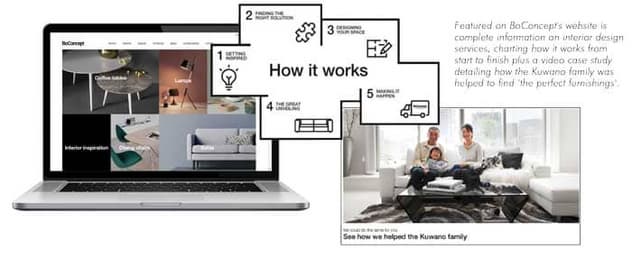
“Finally, we work with an advisory board consisting of three key franchisees. We meet face-to-face four times a year and monthly via Skype to initiate, discuss and conclude on various strategic initiatives – subjects run the gamut! – which then will be rolled out across the chain. Each franchisee represents his/her geographical area. That way, the franchisee has a relatively large say in the strategic direction of the local BoConcept business.”
Steen has been with BoConcept since 2011 and has an extensive background in marketing, advertising and retail. Born in Denmark, he received his MBA in New Hampshire in 1989, moved to New York City in 2003 and is now a U.S. citizen.
“Madison Avenue will serve as our starting point for our upcoming expansion. We are right now looking for new partners across the U.S., with Los Angeles, Atlanta, Chicago and New York as priority locations. Other markets such as San Diego, Austin, Houston, Dallas and Denver, are also key for us .
“BoConcept’s strategic transformation consolidates our franchise model, reducing complexity and enhancing profitability. The efforts we have made to streamline operations are already paying off and we’re eager to see its full potential achieved through our rapid U.S. growth plans.
“More than a franchise," Steen concluded, "BoConcept represents a mindset for modern and sophisticated living elements. Together with strong, motivated franchise partners, the future is bright as we achieve our goal of becoming the true global leader in modern furniture.”
Janet Holt-Johnstone is retail editor at Furniture World Magazine.